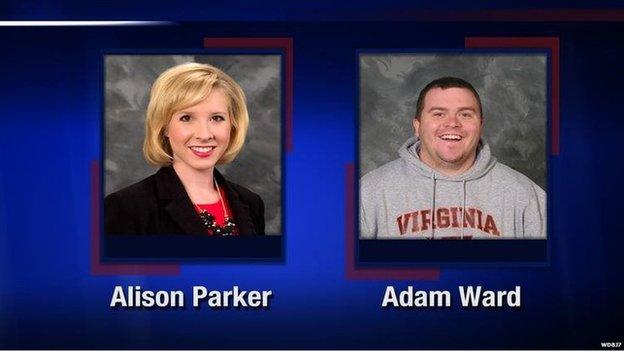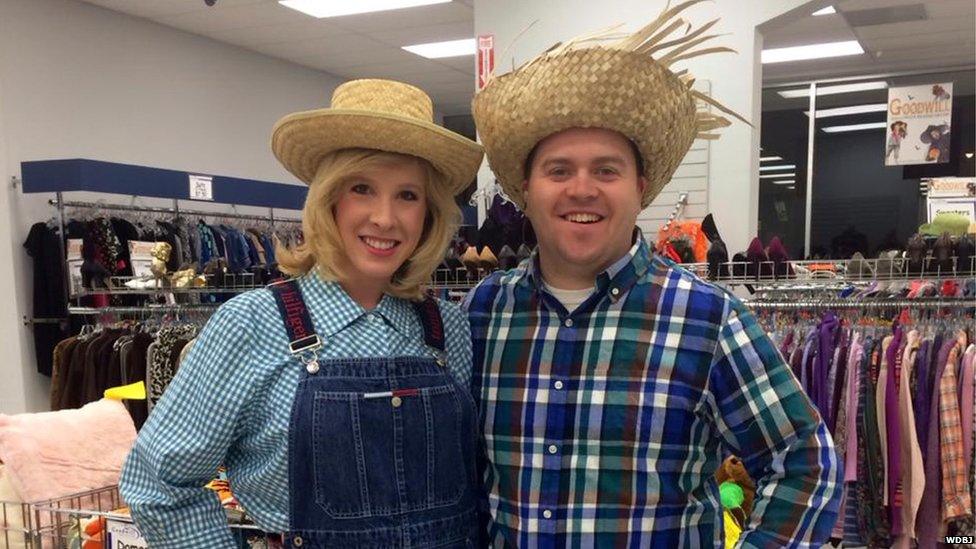Virginia shooting: The murders that rocked breakfast TV
- Published

A memorial has been set up outside of the offices for WDBJ in Roanoke, Virginia
The tragic killing of two US journalists in Virginia has shocked America, but could be particularly traumatising for those who watched the murder happen live on television.
For those watching WDBJ at 06:45 (10:45 GMT) on Wednesday, it suddenly became clear that something terrible was unfolding.
WDBJ TV reporter Alison Parker, 24, and cameraman Adam Ward, 27, were starting a breakfast TV interview about tourism in the town of Moneta, when it was suddenly interrupted by the sound of gunfire.
Viewers heard female screams and "Oh my God!". The camera spun and dropped to the ground, before the feed cut back to a visibly disturbed anchor in the newsroom, who said: "OK not sure what happened there. We will of course let you know as soon as we find out what those sounds were."
Some people took to Twitter straight away to express their shock and concern. Others tried to ascertain what had happened by rewinding their televisions.
It soon became clear. Many found that the broadcast had captured a fleeting image of the gunman - now known to be Vester Lee Flanagan, 41, a disgruntled ex-employee of the TV station (who was referred to professionally as Bryce Williams).
"Screengrab of possible shooting suspect at Bridgewater Plaza from WDBJ viewer. 122 is closed both directions. Dangerous situation. Avoid the area," wrote one user.
How viewers and fellow journalists analysed video of two television journalists being shot dead live on air to try to identify the killer.
"Channel 7 just had a shooting live on TV. Went back and slowed it down and you can see the gunman!" tweeted another.
Bryce Williams's Twitter and Facebook feeds, which have now been suspended, subsequently showed video shot by the gunman.
They showed him raising a handgun, training it on the two journalists and a woman being interviewed, and opening fire 14 times.
Anyone who watched any of the footage is likely to be upset, according to psychologist and trauma expert Christine Courtois.
She says people's reactions to this type of experience vary from being shocked and startled, to being preoccupied by what happened. Others may find themselves temporarily depressed or disorientated, or have trouble sleeping. The important thing to realise is all of these reactions are normal, and help is out there if people need it, or it develops into something more serious like acute stress disorder.
Some people may be more susceptible than others, Courtois points out. Those who have their own history of trauma, or have had a sudden loss recently, for example.

Alison Parker and Adam Ward worked together on the morning show
Children that unwittingly watched the footage are also likely to react in a different way to adults, and it's important for parents to give assurances and limit their exposure to the story, she says.
The fact one of the victims was a familiar face on local television, and some viewers might have chosen to watch her on a daily basis and felt they had a relationship with her might also intensify emotions, according to Courtois.
"We are learning more about the individuals - that they were young and in love, preparing to get married - it adds to the tragedy and sadness," she says.
The very nature of it being on a breakfast show will also have a role.
"The murders interrupted a safe place - people's homes - in an unexpected fashion. There are plenty of guns on TV, but not like this. The shock of it, and the fact the ubiquity of guns and disgruntled employers is an issue anyway, could make this especially upsetting for people."
The two US journalists aren't the first people to be killed on television.
Viewers all around the world were watching live coverage of 9/11 when the second plane hit the World Trade Center.
And in 1987, American politician Robert Budd Dwyer called a news conference in Pennsylvania and then killed himself - and it was broadcast.
But it is still very rare.
Roxane Cohen Silver, a professor of psychology and social behaviour at the University of California, says there hasn't been much research into the extent of trauma caused by a single exposure to traumatic footage such as a live shooting.
But she says repeated exposure to vivid graphic images can lead to long-lasting negative consequences, not just for mental health but also for physical health.

Alison Parker and Adam Ward often filmed light-hearted news reports
"My research into the 9/11 attacks and Boston marathon bombing shows that if people are exposed to looping media footage for a number of hours, it can be really harmful. The more people are exposed to graphic images, the more likely they are to experience post-traumatic stress symptoms.
"So I'd strongly advise people against watching continuous news if broadcasters are looping footage, and tell people not to look it up online."
Frank Farley, a psychology professor at Temple University, agrees. He says broadcasters need to take some responsibility for limiting the exposure.
"If it bleeds it leads - and it can be relentless. As well as being disturbing, it can lead to a number of consequences - people becoming more immune and desensitised, famous copycat actions, and it can create fear in people," he says.
But Farley says the shooting of TV reporter Alison Parker and cameraman Adam Ward is a very unusual case because it was live.
"Watching breakfast TV is such an every day thing, especially for the TV aficionados that live by television. It's their home. The fact that such an everyday thing can suddenly become so scary is a different thing.
"This is going to have a big emotional impact for the people in Virginia. But as a society we're heavily influenced by television, and so in one way, this is close to home for us all," he says.